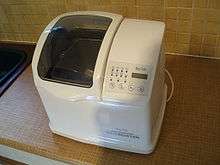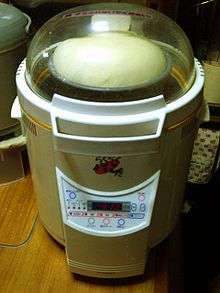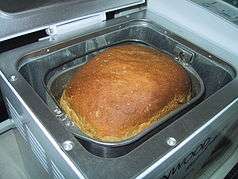Bread machine
A bread making machine or bread maker is a home appliance for turning raw ingredients into baked bread. It consists of a bread pan (or "tin"), at the bottom of which are one or more built-in paddles, mounted in the center of a small special-purpose oven. This small oven is usually controlled by a simple built-in computer using settings input via a control panel. Most bread machines have different cycles for different kinds of dough—including white bread, whole grain, European-style (sometimes labelled "French"), and dough-only (for pizza dough and shaped loaves baked in a conventional oven). Many also have a timer to allow the bread machine to activate without operator attendance, and some high-end models allow the user to program a custom cycle.

History

The first breadmaker was released in Japan in 1986 by the Matsushita Electric Industrial Co. (now Panasonic) based on a year of research by project engineers and software developer Ikuko Tanaka who trained with the head baker at Osaka International Hotel to learn how to optimally knead bread, and involved adding special ribs inside the machine.[1]
The Funai Electric company's machines added a fan to cool the bread after baking, which allowed for full unattended operation, and so claims to have produced the world's first full-fledged entirely automatic bread-making machine on the market, sold as the Raku Raku Pan Da in Japan in 1987[2] and sold in the US as the Dak Auto Bakery model FAB-100-1.
A decade later they had become popular in the United Kingdom, Australia and the United States. While not viable for commercial use due to the fixed loaf shape and the limited duty cycle, bread machines are very suitable for home use, producing their best results when dealing with kneaded doughs.[3]
Use and features
To create a loaf of bread, ingredients are measured into the bread pan in a specified order (usually liquids first, with solid ingredients layered on top) and the pan is then placed in the breadmaker. The order of ingredients is important because the instant yeast used in breadmakers is activated by contact with water, so the yeast and the water must be kept apart until the program starts.
The machine takes a few hours to make a loaf of bread. The ingredients are first rested and brought up to optimal temperature. The ingredients are then turned into a dough by stirring with a paddle. The dough is then proofed using ideal temperature control, and then baked.
Once the bread has been baked, the pan is extracted from the breadmaker, leaving a small indentation or hole from the rod the paddle attaches to. The shape of the finished loaf is often considered unusual, with many early bread machines producing a vertically oriented, square or cylindrical loaf very different from commercial breads; however, more recent units generally have a more traditional-appearing horizontal pan. Some bread machines are in the standard rectangle shape two lb loaf using two paddles. One of the Zojirushi models even has a heating element in the lid to brown the crust.[4]
Bread machine recipes are often somewhat smaller than standard bread recipes, and are sometimes standardized based on the capacity of the machine's pan; most common in the United States market are 1.5 lb/700g units, and the majority of recipes are written for that capacity; however, 2 lb/900g units are not uncommon either. Packaged bread mixes are available, specifically designed for breadmakers, containing premeasured ingredients including flour and yeast, as well as flavorings and occasionally dough conditioners. Only water usually needs to be added. Bread machines generally do not deal well with non-wheat flours, so any recipe that requires a substantial addition of a grain such as rye or corn that lacks gluten will prove difficult at best in a bread machine, as will any dough with unusually large amounts of liquid (such as ciabatta).
Generally, homemade bread goes stale faster than bread from a commercial baker because the former does not include preservatives. However, it is possible (though a bit more difficult) to use a natural leaven or a pre-ferment in breadmaker dough recipes if the starter is sufficiently fast to rise. Sourdough contains a symbiotic culture of yeast and lactobacteria; the yeast provides some flavor as well as carbon dioxide to provide lift, while lactic acid produced by sourdough's lactobacteria greatly preserves bread, as well as affecting its flavor, while pre-ferments provide some of the same benefits as a sourdough culture with the greater predictability of domesticated baker's yeast.
Breadmakers are often equipped with a timer to control when the breadmaking begins. This allows them, for example, to be loaded in the evening but only begin baking early in the morning, to produce a freshly baked loaf for breakfast. They can also be set only to make dough, for instance to be used to make pizza. Some can also be set to make other things besides bread, such as jam, pasta dough, udon or mochi, a kind of Japanese rice cake. One of the most recent innovations is the facility to add nuts and fruit during the kneading process automatically from a tray.[5]
Traditionally, breadmakers take between three and four hours to bake a loaf. However recently "fast bake" modes have become common additions, many of which are able to produce a loaf in under an hour. The bread is generally not of as good quality as that produced by a longer program, but for many users this is a useful feature.
Some breadmakers sold in the 1990s had vertical pans, some horizontal. Today, the vast majority available retail make horizontal loaves. For that reason, they produce a smaller, shorter loaf than their predecessors. It is more difficult to mix a long, horizontal loaf because the ends are distant from the mixer-paddle and gravity does not assist the distribution of the dough. Some machines attempt a better kneading by using two paddles, one at each end. The vertical loaf machine may require a higher powered motor, because the entire mass of the dough-ball is on the paddle as it kneads the dough against the nearby sides of the loaf-pan. Economy in production may account for the manufacturer's preference towards horizontal loaf-pans. Finally, a vertical loaf-pan yields a uniform slice from end to end of the loaf rather than a loaf that is smaller at the ends.
Most of the best bread machines have a cold wall which usually protects the surface getting hotter during the baking process.
See also
- Convenience cooking
- Panettone
- Pullman loaf, bread baked in a narrow, lidded pan, that produces square slices of bread,
- Sliced bread
- Rotimatic
References
- See the case study of the breadmaker's development, as an example of knowledge management and innovation, in Nonaka, I. and Takeuchi, H. (1995), The Knowledge-Creating Company, Oxford University Press.
- "History". funai.jp.
- The King Arthur Flour test kitchen uses bread machines extensively in their recipe testing; for more details, see King Arthur Flour Baker's Companion, Countryman Press, 2003.
- "Bread Machine Reviews &Bread Makers". bakingmybread.com. Archived from the original on 2015-10-20. Retrieved 18 October 2015.
- "Ultimate Guide to Bread Makers". Retrieved 21 July 2017.
External links
| Wikimedia Commons has media related to Bread machines. |
- Bread Machine at the Open Directory Project

